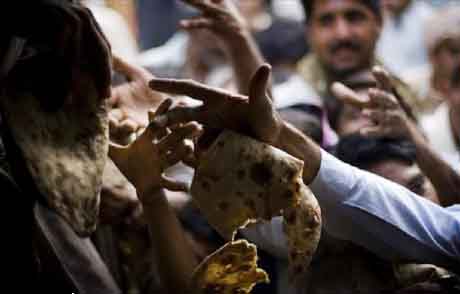 Speculation by large investment banks is driving up food prices for the world’s poorest people, tipping millions into hunger and poverty. Investment in food commodities by banks and hedge funds has risen from $65bn to $126bn (?41bn to ?79bn) in the past five years, helping to push prices to 30-year highs and causing sharp price fluctuations that have little to do with the actual supply of food, says the United Nations’ leading expert on food.
Speculation by large investment banks is driving up food prices for the world’s poorest people, tipping millions into hunger and poverty. Investment in food commodities by banks and hedge funds has risen from $65bn to $126bn (?41bn to ?79bn) in the past five years, helping to push prices to 30-year highs and causing sharp price fluctuations that have little to do with the actual supply of food, says the United Nations’ leading expert on food.
Hedge funds, pension funds and investment banks such as Goldman Sachs, Morgan Stanley and Barclays Capital now dominate the food commodities markets, dwarfing the amount traded by actual food producers and buyers. Purely financial players, for example, account for 61 per cent of investment on the wheat futures market, according to the World Development Movement report Broken Markets.
Speculative investment in agricultural commodities in 2011 was 20 times the amount spent by all countries on agricultural aid. Goldman Sachs, the largest player in the agricultural commodities market, earned ?600m from food speculation in 2009, and Barclays Capital, the world’s third-largest player and largest British bank in this market, earned up to ?340m in 2010, according to the report. Goldman Sachs and Barclays Capital declined to comment.
Before it was deregulated in the year 2000, the agricultural commodities futures market was used mainly by farmers and food buyers seeking to insure themselves against changes in the prices of products such as wheat, maize and sugar. When George W Bush passed the Commodities Futures Modernization Act 12 years ago, there was an influx, led by Goldman Sachs, of purely financial players who had no interest in ever buying food, but who sought solely to profit from changes in food prices, says Olivier De Schutter, the UN special rapporteur on the right to food.
He added: “What we are seeing now is that these financial markets have developed massively with the arrival of these new financial investors, who are purely interested in the short-term monetary gain and are not really interested in the physical thing ? they never actually buy the ton of wheat or maize; they only buy a promise to buy or to sell. The result of this financialisation of the commodities market is that the prices of the products respond increasingly to a purely speculative logic. This explains why in very short periods of time we see prices spiking or bubbles exploding, because prices are less and less determined by the real match between supply and demand.”
Food prices reached a 30-year high in 2008, sparking food riots from Mexico to Bangladesh. Prices rose even higher in September 2010 and, although they have dipped since, they remain above the 2008 crisis level. This has resulted in a “silent tsunami of hunger”, according to the UN World Food Programme.
[vsw id=”K31kZKE3tRs” source=”youtube” width=”590″ height=”360″ autoplay=”no”]





Vision:) I see a puppeteer dressed in a long, black, hooded cape. I can’t see his face clearly because of the big hood which is casting a shadow on his face. I get the impression I’m not supposed to see his face right now. He’s handling several marionettes all at once, and he’s making them dance. The puppeteer’s looking down on them, and although I can’t see his face, I have the impression that he’s smirking. He’s talking in a sinister tone, saying, “Ahhhh, that’s it! You’re right in place now! You move here, and you move over there. Up and down–dance, dance, dance to my tune! You must dance, dance to my music! That’s it, dance, dance to my tune! Uh, uh, uh–no, no–you mustn’t try to remove those strings, for they are what hold you up. If you cut them, you’ll only find yourself tangled in a mess of broken strings as you collapse and fall to the ground. “Dance, marionettes, dance! Don’t try to do it alone, for I’m at the controls, and only I can bring order out of the complexity of all these strings. Dance, marionettes, dance! I’ll move you here, and I’ll move you there. I’m connecting you all firmly to my hand piece, where I can control you, manipulate you, and monitor your movements.
“See? As long as you dance to my tunes, your strings and wires will stay untangled.Down below I see the marionettes dancing on top of a world map. Each marionette represents a country or an area of the world. There’s Hong Kong, Japan, the U.S., Europe, and others. The puppeteer has his strings firmly attached to each one, and he’s manipulating them quite well. Him that will discern, let him discern. The sands of time are falling; the hourglass is running. The stage is set. The curtain is soon to go up as the next scene is about to begin, and the Wicked One is about to be revealed! His stagehands are setting the props in place. They’re adjusting the lights and setting the stage, as the Wicked One prepares backstage. Some of the marionettes have been in the hands of the puppeteer for a long time, and are more tried and proven. All their parts move freely about in response to the touch of the puppeteer’s own hand.
It’s a demonstration of his power to the nations, that should they try to kick and break free from his manipulation, it will only result in instability, and they will soon find themselves in a tangled state and at risk of plunging to the ground in total collapse, just as the marionette who would try to cut his ties. Through selfish lust and the deceitfulness of riches, the marionettes grow dependent on the strings of the puppeteer. But should they decide to cut their strings, to break loose from the control and manipulation of the dark puppeteer, My lifeline remains steady and firm, reaching out to hold them and support them, so that they will not stumble and totter and crumble in ruin. Marvel not at the great rebound of the mighty nation [the U.S.], and be not fooled by a false sense of security, for what is seen is only temporary. For those who lurk behind the scenes, those who sit in high places, know in their hearts the meaning of this apparent quick comeback–that it is only for a time. For this was only a show of force of the Wicked One, a demonstration to those in high standing of who is really the boss. Even the big money boys are as pawns in the hands of the puppeteer. This great fluctuation serves as a reminder to all that the puppeteer alone holds the controls.
The puppeteer’s total power works by fear. The purpose of the great plunge and the mighty rebound of the great nation was to strike fear into the hearts of those who sit in high places, else they be lifted up beyond reason. In these days of extremities, as the pendulum swings from extreme low to extreme high, the puppeteer sends a strong signal that it is indeed he who holds the bag and manipulates the strings, and all must yield to his gestures and signals, else they will be tangled up and put out of commission. These days of extreme swings serve their purpose and motivate these who sit in high places. These events serve as a cue, a signal to man their stations, curtain time, for the scene is about to begin. And all the world will worship the Wicked One